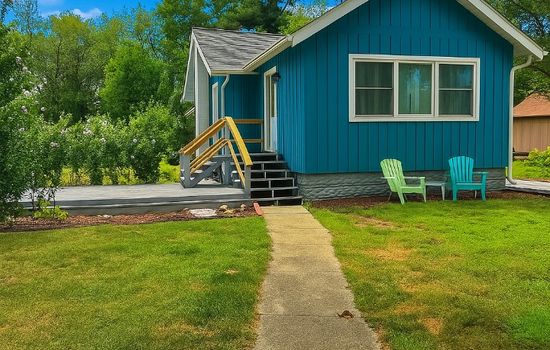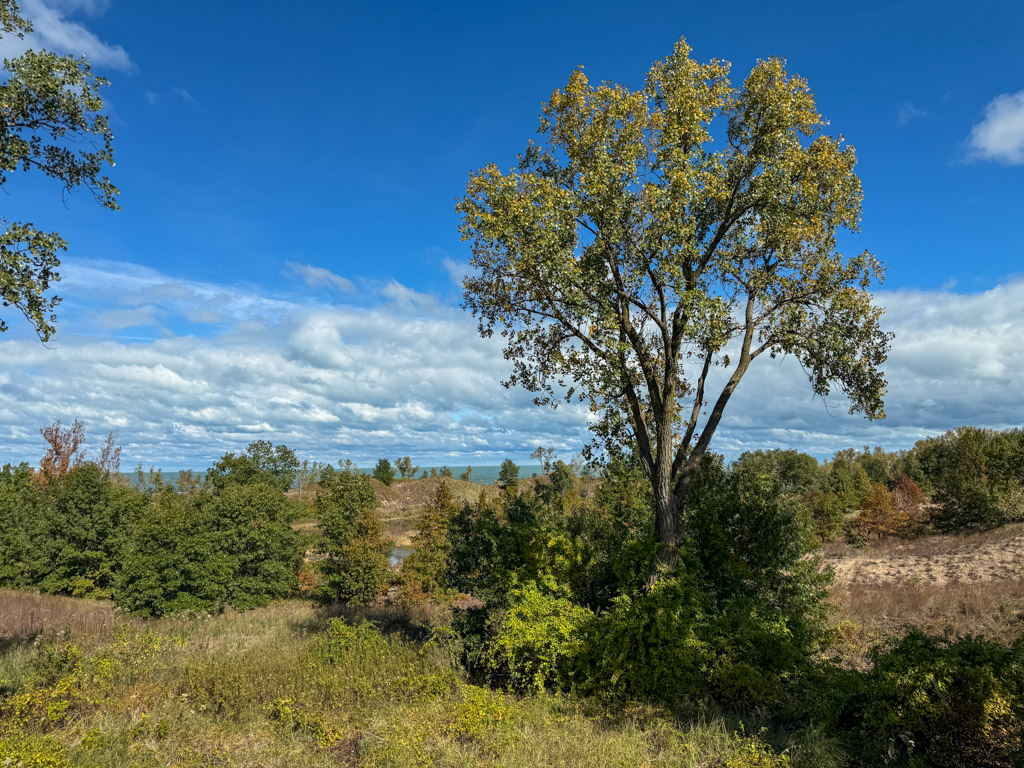The Indiana Dunes Visitor Center is open from 8am to 6pm from Memorial Day to Labor Day, and from 8:30am to 4:30pm the rest of the year, except for Thanksgiving, Christmas, and New Year’s Day.
At Indiana Dunes National Park, the entrance fees are $15 per person or $25 per family for walk-in, bike-in, or boat-in visits. Vehicle passes are $25 for up to 7 days, and motorcycle passes are $20. An annual pass is $45, and the America the Beautiful Annual Pass is $80. Commercial fees vary.
From Chicago, take Interstate 94 east, exit 26 north, and follow scenic State Road 49 to a tranquil lakeside oasis, just 45 minutes away.
At Indiana Dunes National Park, parking is available in lots like Central Avenue Beach with 68 spaces and West Beach with 600 spaces. No accessible spaces at Central Avenue. Parking fees apply: $25 for 7-day vehicle pass or $6 per vehicle at West Beach. No overnight parking. Motorcycles require a separate pass. RVs fit in larger lots like West Beach, but no specific RV size limits are mentioned.【1】【3】【5】
Accessibility & permits
Emergency
- Cell service availability:Partial
Information not accurate?
Help us improve by making a suggestion.
Indiana Dunes National Park, situated along the shores of Lake Michigan, is a tapestry of natural beauty and historical significance. Here, the rugged sand dunes rise dramatically from the lake’s edge, creating a landscape that is both serene and awe-inspiring. The park’s diverse ecosystems support a rich array of wildlife, including migratory birds that can be spotted from the Longshore Birding Platform, and fish such as coho salmon and lake trout that inhabit the waters of the Little Calumet River.
Hikers can explore the myriad trails, each offering a unique perspective on the park’s flora and fauna. The Paul H. Douglas Trail, also known as the Miller Woods Trail, winds through a dense forest of maple, oak, beech, and black gum trees, while the 3 Dune Challenge provides a more arduous but rewarding climb. In the winter, the same trails transform into cross-country skiing and snowshoeing paths, allowing visitors to experience the park’s tranquility under a blanket of snow.
The park is also home to several historic sites, including the 1933 Chicago World’s Fair Century of Progress Homes and the Bailly Homestead, offering a glimpse into the region’s past. During the summer, visitors can enjoy stargazing nights and beach activities at Kemil and Dunbar Beaches, or participate in events like the Indiana Dunes Outdoor Adventure Festival. For those seeking more leisurely pursuits, a ride on the historic South Shore Line or a canoe tour led by park rangers provides a relaxing way to absorb the park’s beauty.
Nearby, the charming town of Chesterton offers a plethora of artisan shops and dining options, making it an ideal base for exploring the park. Whether you are an avid hiker, a nature enthusiast, or simply someone who appreciates the finer aspects of outdoor living, Indiana Dunes National Park is a destination that promises an immersive and enriching experience. As the seasons change, so does the park’s character, from the vibrant colors of autumn to the serene silence of winter, each moment a testament to the enduring allure of this lakeside treasure.
- Area (mi²)
- 24
- Annual visitors
- 2 765 892
- Established year
- 1966
Top 3 Facts about Indiana Dunes National Park
This area is known as the birthplace of the science of ecology, with Henry Chandler Cowles studying ecological succession here, leading to the preservation of habitats like those seen on West Beach’s Dune Succession Trail, which showcases dune formation over time.
This biome, teeming with life, hosts over 1,100 flowering plant species, including rare bog plants and native prairie grasses. Home to 350 bird species, it is a migratory haven. White-tailed deer and coyotes inhabit the land, while Lake Michigan supports 71 fish species. The air is filled with the calls of various frogs and toads, and the skies are dotted with 60 species of butterflies and dragonflies. A great blue heron rookery and the endangered Karner blue butterfly make this a paradise for wildlife enthusiasts.
Along 15 miles of Lake Michigan’s cerulean shoreline, towering sand dunes rise to almost 200 feet, sculpted by the retreat of the last great continental glacier 14,000 years ago. This landscape, a tapestry of oak savannas, prairies, and old-growth forests, hosts over 1,100 flowering plant species and is a critical habitat for migratory birds, making it a biodiversity hotspot with unparalleled natural beauty.
Family programs
- Junior Ranger
- Ranger-led Tours
- Workshops & Hands-on Activities
- Scavenger Hunts
- Family Camping & Overnight
- Arts & Crafts
- Water-based Adventures
Travel Tips
Plan Ahead
Plan a 3-day visit to avoid summer crowds; arrive in spring for wildflowers or fall for vibrant colors. Start at the visitor center, pack for varied terrain and rest stops, and bring meals as options are limited. Enjoy the 3 Dune Challenge or Cowles Bog Trail hikes.
Pack Appropriately
Pack layers for changing weather, sturdy hiking shoes, and a first aid kit. Bring a tent, sleeping bag, and headlamp for overnight stays. Don’t forget water, snacks, and a map. Check the season for specific gear needs.
Respect Wildlife
Stay on trails to protect delicate dune plants and wildlife. Avoid off-trail hiking to prevent erosion and respect fragile ecosystems. Wear insect repellent and check for ticks after hikes. Leave all rocks, animals, and plants undisturbed. Take out what you bring in to maintain the area’s natural balance.
Stay Informed
Stay on marked trails, avoid ledges and water edges, and check weather conditions. Follow park rules and signs. For emergencies, call 911 or park authorities at 219-926-7561. Be cautious of seasonal temperature and storm changes.
Seasons
In spring, mild temperatures (50s-60s°F) and blooming wildflowers make this a perfect time to hike and explore. Enjoy the Maple Sugar Festival in June, or join daily Trash Trekkers and Sunday Chellberg Farm Open Houses. Ideal for outdoor enthusiasts, with gentle spring rains and vibrant ecosystems awakening.
Summer brings warm temperatures (70s-80s°F) and sunny days, ideal for hiking, beach-going, and bird watching. Enjoy the Indiana Dunes Outdoor Adventure Festival in September, or hike through moss-covered bogs and spot rare birds. Perfect for outdoor enthusiasts.
Experience autumn’s vibrant hues in September, with mild temperatures (60s-70s°F) and crisp weather. Attend the Outdoor Adventure Festival, featuring hiking, paddling, and birding events, culminating in the Duneland Fall Festival with live entertainment and historic farm demonstrations. Ideal for nature enthusiasts and families.
Experience winter’s serene beauty from December to February, with temperatures ranging from 18°F to 32°F. Crisp air, occasional snow, and clear skies after cold snaps make for a unique and invigorating visit, though windy lake breezes can be severe. For the adventurous, it’s a tranquil time to explore.
Information not accurate?
Help us improve by making a suggestion.
Where to stay
Frequently Asked Questions
Ready to dive into what Indiana Dunes National Park has to offer? Let’s tackle some of the burning questions you might have as you plan your visit!
-
The closest city with affordable places to stay is Michigan City, located on the eastern end of the park. Other nearby cities include Gary to the west. Michigan City is a convenient option for visitors.
-
The Calumet Dunes Trail is a great option for kids, as it is a short 0.5-mile paved trail that is easy to navigate and offers shade, making it ideal for young children and hot days. The Mt. Baldy Beach Trail, a 0.36-mile trail, is also a good choice, providing a simple walk to the beach with great views of Lake Michigan. Both trails are suitable for families with toddlers or strollers.
-
Dogs must be on a leash no longer than 6 feet and owners must remove pet waste. Leashed dogs are allowed everywhere except the lifeguarded swim areas at West Beach when lifeguards are present.
-
Parking is not included with admission; an entrance pass or annual pass is required to park in the lots. The pass covers entry for the vehicle and its occupants, but parking spaces are subject to availability, especially during peak seasons.
-
The main attraction is the 15 miles of beaches along the southern tip of Lake Michigan. These beaches offer activities like swimming, sunbathing, and access to various hiking trails and scenic views. The beaches are a key part of the park’s natural beauty and recreational opportunities.










